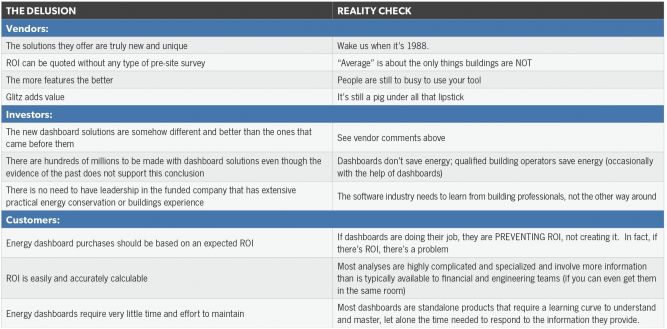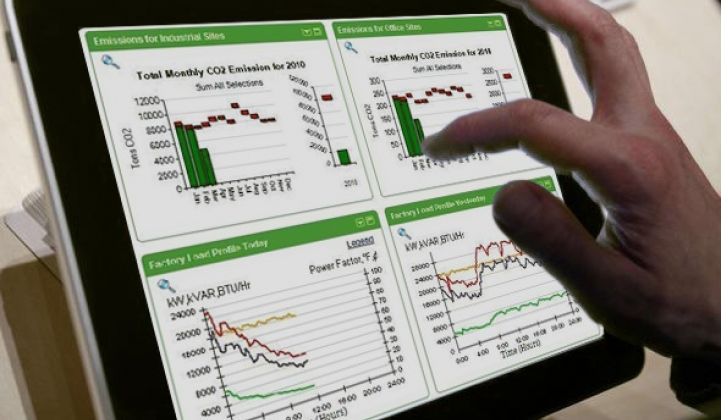Delusion: a persistent false belief held in the face of strong contradictory evidence.
Delusion may be a harsh word when applied to energy dashboards, the current darling of the intelligent building movement and venture investment community, but it is our opinion that the way they are marketed, sold, and purchased represent fundamental misunderstandings of the true nature, value and purpose of these tools.
We believe that in many cases the wrong tools are being purchased or the tools are being used ineffectively.
Don’t get us wrong, by putting the words 'dashboard' and 'delusion' in the same title, we are not proposing that dashboards are of no value. On the contrary, we think that the really good ones can be valuable tools. The purpose of this piece is to lay out our prescription for how we believe they should be evaluated by vendors, investors and customers.
We start with the following observations that portray what we see as some of the most prevalent delusions some vendors, investors and customers are under when it comes to energy dashboards.

Click on image to view larger
Hope Springs Eternal
The burgeoning green building movement driven by the LEED Green Building Rating System and complemented by growing corporate social responsibility programs focusing on carbon reductions has led to the recognition of the importance of building intelligence. As a result, energy dashboard companies are once again sprouting like toadstools after a rain. Sadly, these well-meaning souls, sorely lacking industry experience, are also laboring under the delusion of their dashboard’s ability to mine the “green gold” in buildings. (Just to be clear, we are not suggesting that presence of “green gold” is delusional, but that the efficacy of the miners and the mining techniques may be.)
Regrettably, the dashboard companies are not alone in being caught up in this delusion; the source of these ultimately unproductive millions is an investment community that either has recurring memory loss or perhaps has found the hidden, overwhelming success stories that energy efficiency professionals such as us have missed in our decades of experience. Regardless of the cause, investors seem to continually throw money into the same failed energy dashboard strategies over and over again.
From the post Jimmy Carter era, to the dot-com bubble of 2000, to the dashboard “green rush” of today, the plains are littered with dead energy-efficiency “solutions” that often spend millions to save thousands. Those of us who have been in the so-called green space a long time (in other words, since before it was called the green space) have seen concept and tool “bubbles” before, and we can ascertain with a fair amount of confidence that 1) this is a bubble and 2) like those before, it will eventually burst. One constant that all these bubbles have in common is that the vast majority of solution providers all lack much experience in the building industry -- including all of the perverse and conflicting “incentives” therein.
There is only one thing that has ever saved energy in buildings: teams of skilled professionals supported by good tools and adequate budgets. Two key questions people should ask before and after the bubble bursts are: How many of these companies will actually survive (or deserve to)? And how long will it take for the market to wake up to the real solution that skilled professionals save energy, not technologies or tools, such as dashboards?
Dashboards Are the Answer! (But What Was the Question?)
Like China’s “billion consumers,” the lure of providing a quick fix for the very large and very real energy efficiency potential in buildings appears to be irresistible, particularly to those with little domain expertise. To wit, corporate powerhouses Microsoft and Google brought forth home energy dashboard products to much fanfare. It’s not hard to visualize hours of whiteboard meetings with software developers downing Red Bull and salivating over the “killer app” their customers were going to flip over. Finally, Silicon Valley was going to bring buildings and their occupants into the 21st century!
There was only one problem: it appears that nobody bothered to ask if customers really wanted to manage their home energy spending. Neither Google nor Microsoft had complicated applications, but the value they provided did not equal the time users wanted to or were able to spend with them. Naturally, they failed.
Although they are an example from the residential sector, we mention these well-intentioned efforts because a similar sort of thinking underlies the way many of the dashboards are being sold to the commercial sector. We find far too often that vendors are severely deluded regarding what the market is looking for, which leads to the thinking that “more is more” when it comes to energy dashboard features, reports and gadgets. Sure, facility managers may use their new dashboard for awhile and some even ‘forever,’ but most of them are either like kids playing with their toys right after Christmas, or they use it because their boss is watching.
In reality, most facility managers’ time is almost always a triage of which of the daily emergencies is the greatest threat to their job. Once people are looking the other way, typically these folks will go back to the way they have always done things, unless there is deep expertise behind the dashboard to support them. Unfortunately this expertise is not to be found within most dashboard companies, principally because investors have failed to understand, or understand too late, that nothing scales in the building industry without good people.
Only too late do vendors (and their investors) realize that they spent too much time and money developing overpriced bloatware that looks awesome in an investor’s boardroom, but is too time-consuming, too complicated and ultimately not effective enough for facility people to use on an ongoing basis.
It may seem obvious, but the value of a dashboard tool is only as much as the time people are willing to take to use it and the ability of users to understand and follow up on the information they provide. As with most bubbles, the dirty little secret soon to be revealed is that all the glowing case studies of success on dashboard company websites are the exceptions that prove the rule.
Back to the Future: Dashboards of Today and Yesteryear
We could split hairs regarding what can be defined as an “energy dashboard,” but, for the purposes of this discussion, we define it as any type of software that lies on top of a building automation system and provides some type of energy reporting, with the primary aim of saving energy.
Energy dashboards have been with us for over 30 years, beginning with DOS-based software in the 1980s and appearing in every shape, size, and color. Regardless of their bells and whistles, most of today’s dashboards are likely to follow their historical brethren into oblivion.
In the last few years, a business solution called cloud-based software-as-a-service (SaaS) has been touted as the next leap of technology. The vendor’s pitch is that rather than purchasing the software outright, customers simply pay for a monthly, quarterly or annual subscription. We would argue that from the customer’s point of view, SaaS is not really a new business model at all, but merely an update of the application service provider (ASP) model of the 1990s. If you were around back then, you may recall all of the hype surrounding ASP portals and dashboards.
Where did all those players go? Suffice it to say that most are no longer with us, and none lived up to the hype.
So why didn’t those '90s companies succeed? In our next installment, we will give our take on this question.
***
John Pitcher founded Scientific Conservation and is currently the COO of EcoTech International. Known as the inventor of automated fault detection and diagnosis, John’s 40-year career covers many product-development and leadership roles in the building automation and energy efficiency field.
Widely known as the “Father of LEED,” Rob Watson is CEO of EcoTech International, which brings integrated sustainability solutions to clients in the U.S., Russia and China. Rob was a semi-finalist for the 2011 international Zayed Award for Energy Efficiency and was the first recipient of the USGBC Leadership Award. Author Tom Friedman has called Rob “one of the best environmental minds in America.”
Shaun Hill is a 15-year building energy efficiency industry veteran, most recently as Project Manager for Scientific Conservation.



